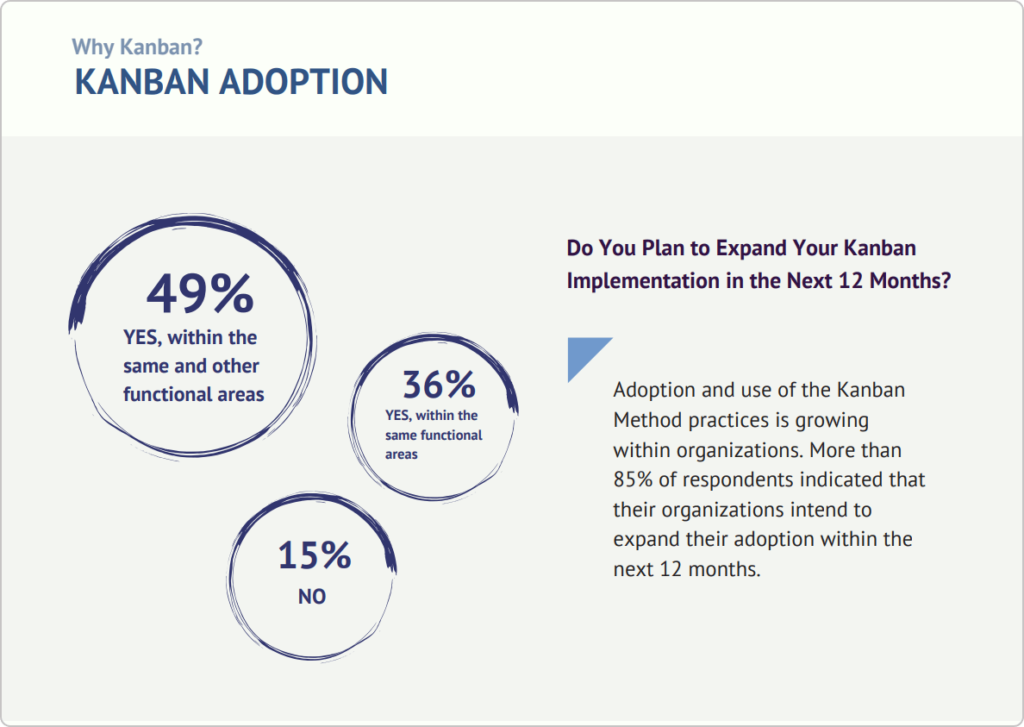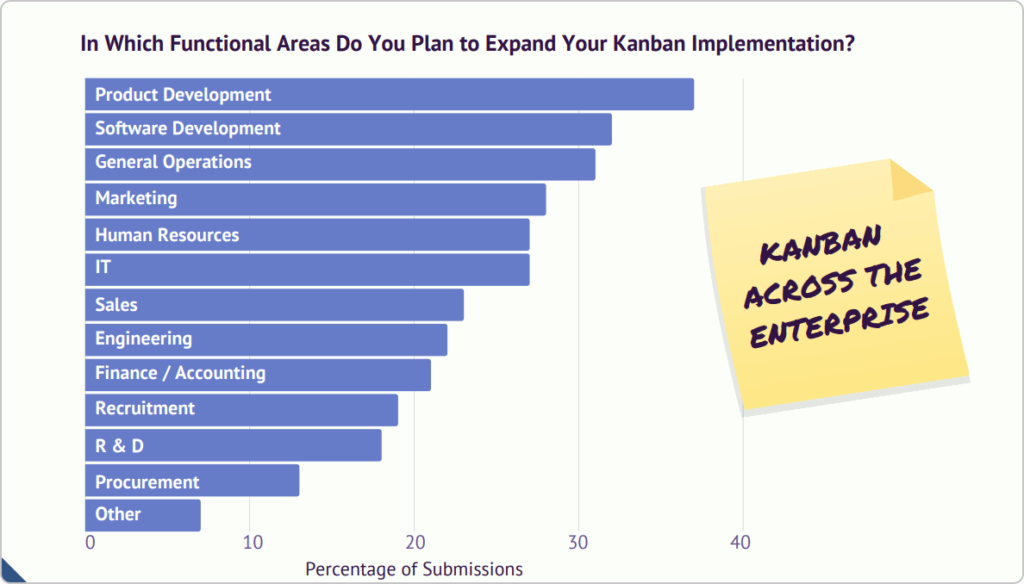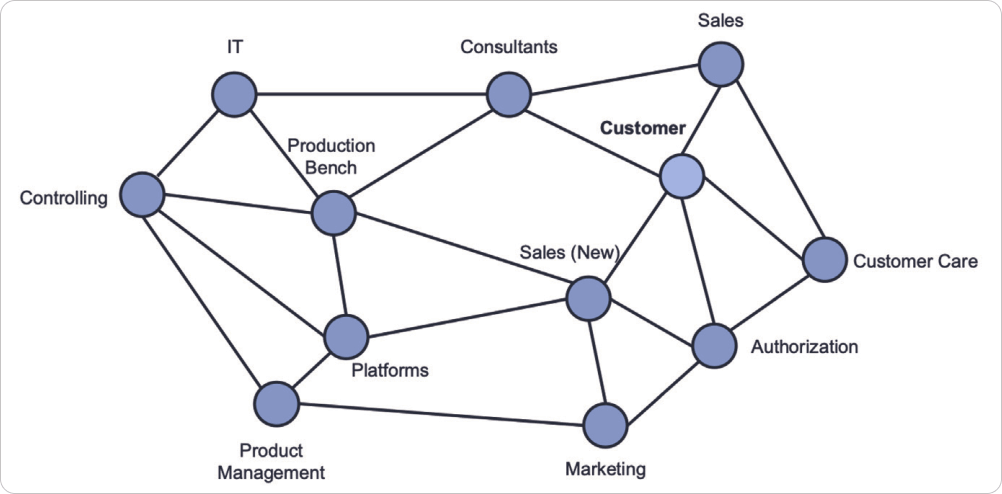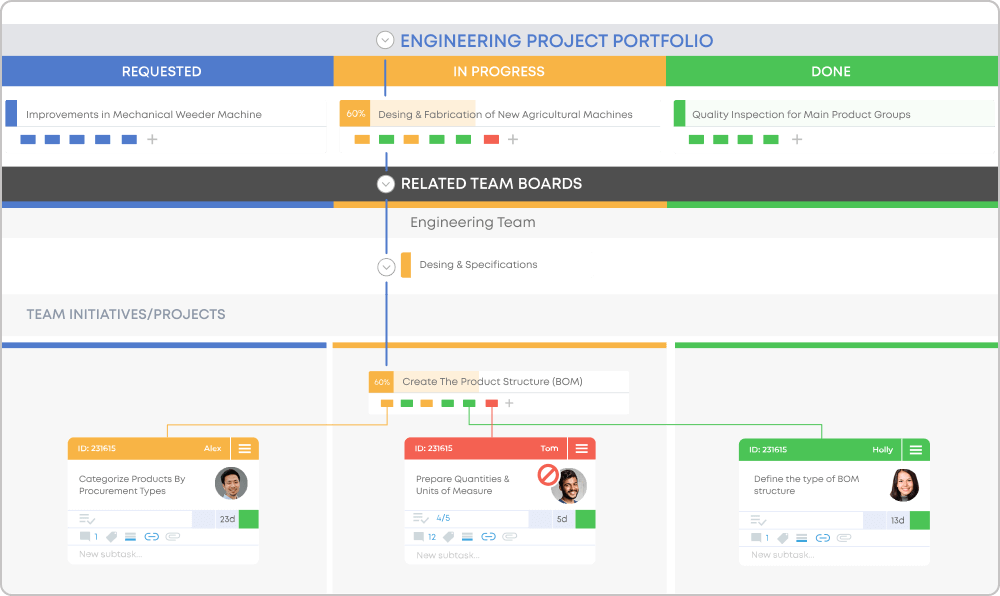It's no secret that having a good strategy is of vital importance in the business world. From developing the right product to positioning it on the market, it all comes down to strategy.
And yet, when implementing Kanban (or Lean/Agile, for that matter), we still see many companies that approach it as a one-time endeavor. Ultimately, this leads to poor results and the inability to reap the full rewards of the method.
So, what can you do about it? Let's start with the "why".
Why Do You Need a "Kanban Strategy" When Adopting the Method?
"Kanban is more than just sticky notes on a wall".
We've been preaching this for years. While we see positive trends in the adoption of the method based on this year's "State of Kanban" report, there are still companies that believe Kanban is just about moving cards from left to right on a whiteboard.

In other words, they start using some of the Kanban practices (usually visualization) without having the right strategy in place. As strategy relates to something long-term, if you don't have it, you limit yourself to short-term gains only. Eventually, this leads to a lack of sustainable results, which often forces companies to revert to their old management ways or try something else, claiming that Kanban didn't work for them.
Now, don't get me wrong.
There are many reasons why Kanban may or may not work for you. The important thing is that you should approach the implementation from a strategic, not a local point of view, if you want to see sustainable results. To do that, you first need to understand the logic behind Kanban and then apply its practices.
Having said that, Kanban is a workflow management method defined by change management and service delivery principles. The idea is first to recognize your current organizational capabilities and then continuously evolve them to achieve agility. This is a hard task that requires a lot of discipline, and it doesn't happen overnight.
That's why you need a good strategy to follow.
A Global Strategy for Introducing Kanban
To build a strategy for Kanban adoption, start with the culture.
This means making sure that people clearly understand that Kanban is a non-disruptive evolutionary method, aiming to improve the existing process in small steps. It also means introducing the following principles to the way you work:
- Start with what you do now
- Agree to pursue improvement through evolutionary change
- Encourage acts of leadership at all levels
- Understand and focus on customer needs and expectations
- Manage the work, let people self-organize around it
- Regularly review the network of services and its policies in order to improve outcomes
Now, this is way easier said than done.
That's why make sure you train all the relevant stakeholders on these principles because they represent the mindset behind "why are we doing Kanban?". Once there is a common understanding and you've built a shared purpose, you can start gradually adopting Kanban's practices to bring the new work philosophy into action.
And while you can experiment with Kanban across a single team in the beginning, don't stray away from the global mindset. Think about how your products/services move around multiple systems in the organization before they reach the customer's hands.

STATIK
In fact, Kanban is all about systems thinking which is represented by a process called "STATIK" (Systems Thinking Approach To Implementing Kanban). Once you've grasped the mindset behind the method, STATIK can be a great Kanban implementation strategy.
To execute it, follow the steps below:
"Step 0: Identify Services
For each service ...
1. Identify sources of dissatisfaction - What are the people involved in service delivery dissatisfied with? What are customers dissatisfied with? All these sources of dissatisfaction provide motivation for change which is key for a successful Kanban initiative/project.
2. Analyze demand - What do customers request, through which channels? What are the types of work and patterns in demand? This information is key to develop the full picture of the work that arrives at the system. Remember, manage the work, not workers!
3. Analyze system capabilities - What are the capabilities of the system with regard to how much of the customer demand is being delivered, of what type, and how fast and predictable? This step typically requires historical data.
4. Model the Workflow - Which are the activities that each of the identified work item types go through? They might be sequential, parallel, or in no particular order. Later, these will be the basis for defining the columns on the Kanban board.
5. Identify classes of service - Understand how items enter and get treated in the system using Kanban classes of service.
6. Design the Kanban system - Based on all the insights gained in the prior steps, the Kanban system is then designed. A Kanban system naturally consists of a board and tickets, plus other important elements such as metrics, cadences, and policies."
Source: The Official Kanban Guide
If you've never heard of STATIK before, you're probably a little confused about these steps. While we could go into a lot more detail about each one of them, this will be way beyond the scope of this article. So instead, there are a few important things you need to take away from here:
- First of all, these steps are iterative, not necessarily sequential. This emphasizes the focus on continuous improvement, which you should look to embed in your company's DNA before moving forward.
- Second, you should recognize that your company is a network of interdependent services and every organizational function (IT, customer support, etc.) is responsible for producing one. This means that when you start visualizing work on boards, don't limit yourself to a single team or service. Look to visualize dependent services, too, so you can put on display the entire value stream that a customer request goes through.

- Third, observe your current delivery capabilities without revolutionizing anything. And here comes the crucial step. Once that's done, start building a Kanban system based on your observations.
To do that, you can limit WIP (work in progress), define multiple commitment points on your boards, visualize queue stages, or implement many other practices. If you want to learn more about them, a great source is the Kanban Maturity Model.
But while the practical approach is important, it's not the point of this article.
Instead, the point is to realize that those practices are applicable everywhere in the organization. The goal of Kanban is not just to improve local delivery capabilities. It's about building a network of interconnected Kanban systems to become more agile and resilient on a global level.

Balance and Alignment
As implementing Kanban is far from a one-time endeavor, you need to keep it on the right track. In other words, it's essential to achieve alignment and balance between the different Kanban systems.
To do this in practice, you can use the Kanban cadences. They represent a series of regular feedback loops to plan and review delivery capabilities and strategic objectives.
Again, this is far easier said than done, and going into details about these cadences is beyond the scope of the post. However, the important thing is to understand that you can apply them from a team up to the strategic level. The main idea is for each lower-level cadence to pass on information upwards and vice versa.
This leads to a constant exchange of delivery information between services in the company. As a result, you can study what Kanban practices work for your scenario, how "fit for purpose" your systems are, and what you can do to improve them.
Final Words
I think a reasonable conclusion to this article would be to focus on the long-term strategy, not the short-term gains. While visualizing work on a board can give you some good results, they will not be sustainable if you just stay there.
Instead, explore the depths of Kanban. It is a lightweight method that has the potential to transform entire organizations so they can achieve resilience in today's turbulent market.
To make it work, you need to view things more strategically with the goal of improving the entire flow of work. This will help you deliver value to customers at the right place, at the right time.

Nikolay Tsonev
Product Marketing Manager
Nick is a strategic thinker, passionate about marketing, sales enablement, project management and productivity. An avid sports and Star Wars fan, he spends most of his free time in the gym or the playing field.



